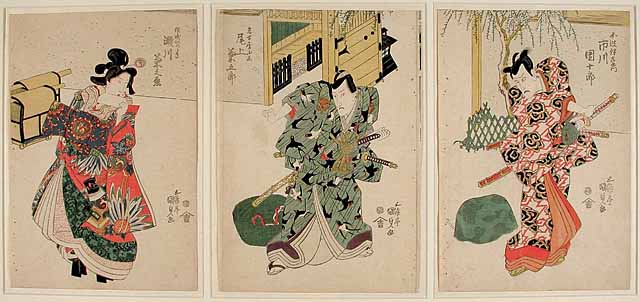
Ichikawa Danjuro VII as Fuwa Banzaemon (right), Onoe Kikugoro III as Nagoya Sanza (centre) and Segawa Kikunojo V as the courtesan Katsuragi (left)
Ichikawa Danjuro VII as Fuwa Banzaemon (right), Onoe Kikugoro III as Nagoya Sanza (centre) and Segawa Kikunojo V as the courtesan Katsuragi (left)in Ukiyo-zuka hiyoku no inazuma (Ukiyo’s sword hilt, a double grave mound and the mark of the lightning bolt) performed at the Ichimura theatre in 03/1823
Private collection
This famous Saya-ate (‘Scabbards clashing’) confrontation scene occurs in the third act of the play, which was written for these performers and first performed in this production in 1823. The idea derived both from the established Kabuki convention of a Saya-ate scene, and from the 1807 novel by Santo Kyoden, Mukashi banashi inazuma hyoshi (An Old Time Lightning Bolt Tale). Fuwa Banzaemon carries a sword named ‘Thunder’ and wears a kimono decorated with a pattern of ‘lightning-in-the-clouds’.
His rival Nagoya Sanzaburo (Sanza for short) carries a sword named ‘Amorous Swallows’ and wears a kimono decorated with a ‘swallows-in-the-rain’ pattern. Unaware of each other, they make simultaneous entrances along the two raised passageways (hanamichi) through the audience. As they pass on the main stage (which represents Nakano Street in the Yoshiwara pleasure district at cherry blossom time), their sword hilts clash. They exchange insults, remove their green sedge travelling-hats, recognize one another and draw swords to fight over the courtesan Katsuragi. Katsuragi rushes forward and persuades them to call a truce.
Loan 556

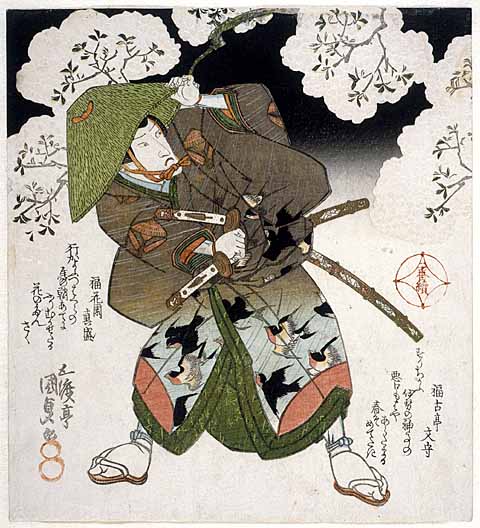
Ichikawa Danjuro VII as Fuwa Banzaemon (right) and Onoe Kikugoro III as Nagoya Sanza in Sato no haru meibutsu amigasa (Famous sedge hats during spring in Yoshiwara) performed at the Kawarazaki theatre in 01/1827
Given to the Fitzwilliam Museum by E. Evelyn Barron in 1937
A surimono diptych showing the famous Scabbards clashing (Saya-ate) scene in a revival (with a different name) of the play that first brought Danjuro VII and Kikugoro III together in these highly successful roles in 1823. This scene was subsequently performed as a separate dance-drama. Fuwa Banzaemon carries a sword named Thunder and wears a kimono decorated with a pattern of lightning-in-the-clouds.
His rival Nagoya Sanza carries a sword named Amorous Swallows and wears a kimono with a swallows-in-the-rain pattern tied with a sash of knitted rope. Unaware of each other, they make simultaneous entrances boasting of their fame, along the two raised passageways (hanamichi) that run through the audience to the main stage. As they pass on the main stage, which represents Nakano Street in the Yoshiwara pleasure district at cherry blossom time, their sword hilts clash a breach of etiquette demanding an apology. This depiction shows them at the moment when they raise their deep sedge traveling-hats and recognize each other, before drawing swords to fight over the courtesan Katsuragi, whom they both love.
It seems that Danjuro VII was only recruited for this performance after a fire prevented him from appearing as Kagekiyo at the Ichimura theatre
Collections records: P.474-1937 & P.475-1937
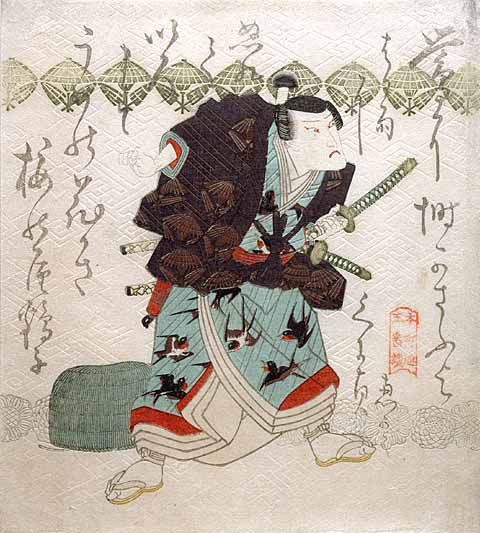
Ichikawa Danjuro VII as Fuwa Banzaemon (right) and Onoe Kikugoro III as Nagoya Sanza (left) in the Saya-ate (Scabbards clashing) scene
c. 1827-30
Given to the Fitzwilliam Museum by E. Evelyn Barron in 1937
The outer sheets of a surimono triptych showing this famous scene from the play first performed with these actors in the same roles as Ukiyo-zuka hiyoku no inazuma (Ukiyo’s sword hilt, a double grave mound and the mark of the lightning bolt) at the Ichimura theatre in 1823, and revived many times. The missing central sheet shows Segawa Kikunojo as the teahouse mistress Ofuku who intercedes to stop the ensuing duel. The numerous prints showing this scene depict the characteristic costume patterns of Nagoya Sanza (‘swallows-in-the-rain’) and Fuwa Banzaemon (‘lightning-in-the-clouds’). All three prints also have the ‘triple-umbrella’ (sambon-karakusa) pattern of Nagoya Sanza across the top, and Fuwa’s ‘lightning-in-the-clouds’ pattern embossed in the background. They are each stamped with the inscription Honchoren sanbantsuki (a set of three for the Honcho poetry group).
Collections Record: P.515-1937
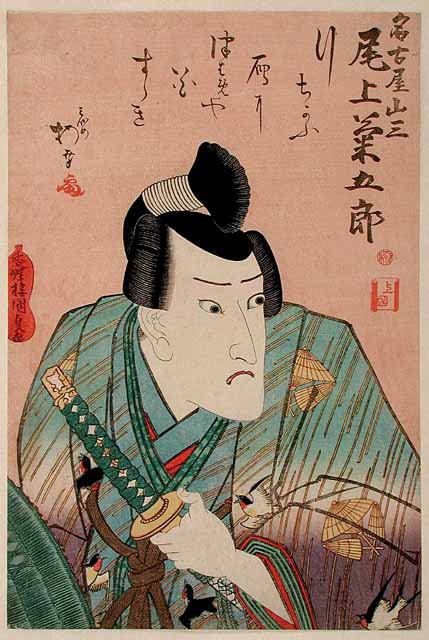
Ichikawa Ebizo V (formerly Danjuro VII) as Fuwa Banzaemon (right) and Onoe Kikugoro III as Nagoya Sanza (left) in Nagoya obi kumo ni inazuma (A Nagoya rope sash and robes with lightning bolts amidst clouds) performed at the Morita Theatre in 09/1836
Private collection
This pair of portraits commemorates a revival (with a different name) of the play that brought Danjuro VII (now acting as Ebizo V) and Kikugoro III together in these highly successful roles. The well-known rivalry between the two actors added spice to their confrontation in this famous ‘Scabbards clashing’ (Saya-ate) scene in the third act, which had featured in prints associated with earlier productions. Fuwa Banzaemon carries a sword named ‘Thunder’ and wears a kimono decorated with a pattern of ‘lightning-in-the-clouds’. His rival Nagoya Sanza carries a sword named ‘Amorous Swallows’ and wears a kimono with a ‘swallows-in-the-rain’ pattern tied with a sash of knitted rope. Unaware of each other, they make simultaneous entrances boasting of their fame, along the two raised passageways (hanamichi) that run through the audience to the main stage. As they pass on the main stage, which represents Nakano Street in the Yoshiwara pleasure district at cherry blossom time, their sword hilts clash. They exchange insults, remove their green sedge travelling-hats, recognize one another and draw swords to fight over the courtesan Katsuragi, whom they both love.
Above the actors’ heads are hokku poems (haiku) written by the actors themselves. Danjuro’s poem is signed with his poetry name Hakuen. It alludes to his repeated appearances in this role and to the lightning-in-the-clouds pattern on his robe, as well as to the date of this performance in the ninth month.
Bolts of lightning Inazuma mo appear countless times kazu o kasanete in the ninth month! kugatsu kana.
Kikugoro’s poem is signed with his poetry name Baiko. As well as alluding to the swallows-in the-rain pattern on his robes, the poem suggests a comparison between the action in this scene when the actors pass each other on stage, and geese and swallows flying past each other as one arrives and the other departs in the autumn, the season of this performance:
Passing by each other Yuki-chigau wild geese and swallows kari ni tsubame ya over ripened pampas grass. hanasusuki.
Loan 290

Ichikawa Ebizo V (formerly Danjuro VII) as Fuwa Banzaemon seen in a mirror
c. 1849
Given to the Fitzwilliam Museum by E. Evelyn Barron in 1937
Fragment of a much larger surimono made for the Go poetry group, with a text of poems praising the actor, and the image of a peony (one of the Ichikawa family symbols) designed by Totoya Hokkei (1780-1850). The complete print bears Kunisada’s seal reading Kunisada aratame ni-sei Toyokuni no in (Seal of Kunisada changing to Toyokuni II), which records his adoption of his master Toyokuni;s name in New Year 1844.
The print was probably designed in 1849, when his son Danjuro VIII went to visit his father Ichikawa Ebizo V (formerly Danjuro VII) in exile in Osaka. Danjuro VII had been banished from Edo by the government (bakufu) in 1842 in punishment for his luxurious lifestyle as part of the Tempo reforms. The print shows Danjuro VII in one of his most famous roles, which was depicted many times in prints with the characteristic lightning-in-the-clouds pattern on Fuwa Banzaemon’s costume. The device of portraying an actor reflected in a mirror was used by Kunisada many times.
Collections Record: P.516-1937
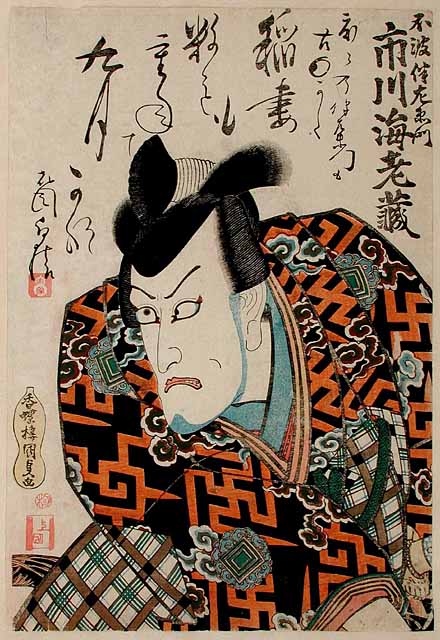
Ichikawa Ebizo V (formerly Danjuro VII) as Fuwa Banzaemon in Nagoya obi kumo ni inazuma (A Nagoya rope sash and robes with lightning bolts amidst clouds) performed at the Morita Theatre in 09/1836
Private collection
Loan 252



